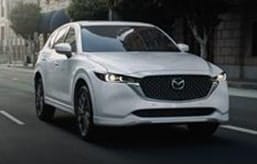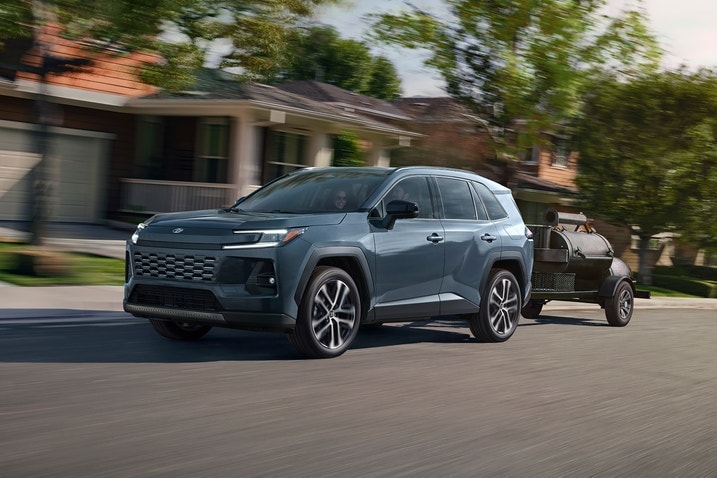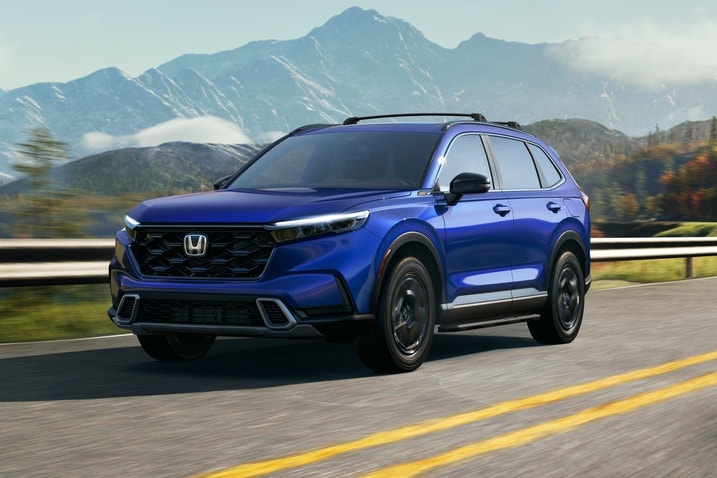- Toyota drops the RAV4’s gas-only powertrain for 2026, making the hybrid the entry-level model.
- Honda’s CR-V Hybrid is another very popular gas-electric in this segment.
- Which of these compact hybrid crossovers is right for you?
2026 Toyota RAV4 vs. 2025 Honda CR-V: Hybrid SUVs Go Head-to-Head
The new hybrid-only 2026 RAV4 is poised to take the fight to the gas-electric version of Honda’s best-seller
Toyota has gone all in with hybrids on the best-selling RAV4. For 2026, the hybrid becomes the RAV4’s base powertrain, while a plug-in hybrid continues as an option. To see how the redesigned Toyota compact crossover compares to one of its main rivals, the Honda CR-V Hybrid, we’ve collected the most important specs and details on both.
Note that Toyota hasn’t shared some important information yet, including fuel economy numbers, interior dimensions and pricing.
Engines and fuel economy
With the hybrid powertrain becoming the RAV4’s base offering, Toyota also added a front-wheel-drive version; previously, opting for either hybrid RAV4 got you standard all-wheel drive, and front-wheel drive was reserved for the gas-only powertrain. With front-wheel drive, the 2026 RAV4 has 226 horsepower, while the all-wheel-drive model packs 236 ponies thanks to the addition of a rear-axle electric motor. For the CR-V’s extra-cost hybrid powertrain, output is 204 horsepower regardless of whether you select front- or all-wheel drive.
The CR-V Hybrid has EPA combined fuel economy figures of 40 mpg with FWD and 37 mpg with AWD. For reference, the 2025 RAV4 Hybrid AWD achieves 39 mpg combined in most trims or 37 mpg combined for the Woodland Edition. You can expect the 2026 RAV4 Hybrid AWD to do as well or slightly better, and for the new front-wheel-drive RAV4 Hybrid to be more efficient still.
2026 Toyota RAV4 Hybrid vs. 2026 Honda CR-V Hybrid
Spec | 2026 Toyota RAV4 Hybrid | 2026 Honda CR-V Hybrid |
|---|---|---|
| Engine | 2.5-liter inline four-cylinder, one or two electric motors | 2.0-liter inline four-cylinder, electric motor |
| Horsepower | 226 hp (FWD) / 236 hp (AWD) | 204 hp |
| Torque | N/A | N/A |
| Transmission | CVT | two-motor hybrid system |
| Drive type | FWD or AWD | FWD or AWD |
| Fuel economy | N/A | 40 combined mpg (FWD) / 37 combined mpg (AWD) |
Interior
Both of these compact crossovers seat five, but we don’t yet know how their passenger space stacks up. It’s a pretty safe bet that the new RAV4 will be at least as accommodating as the 2025 model, which is generally pretty closely aligned with the CR-V’s measurements. One exception is rear seat legroom, where the 2025 RAV4 has just 37.8 inches compared to the CR-V’s 41.0 inches. Perhaps Toyota has made gains there for 2026.
The same goes for cargo space. The current RAV4 Hybrid has similar volume with the rear seats in place (37.5 cubic feet compared to a best of 36.3 cubic feet for the Honda) and a bit less space with those seats folded (69.8 cubic feet versus 76.5 cubes).
2026 Toyota RAV4 Hybrid vs. 2026 Honda CR-V Hybrid
Spec | 2026 Toyota RAV4 Hybrid | 2026 Honda CR-V Hybrid |
|---|---|---|
| Headroom (front/2nd row) | N/A | 38.2 in/38.2 in |
| Legroom (front/2nd row) | N/A | 41.3 in/41.0 in |
| Number of seats | 5 | 5 |
| Cargo volume (2nd row up) | N/A | 34.7–36.3 cubic feet |
| Cargo volume (2nd row folded) | N/A | 76.5 cubic feet |
Technology and safety equipment
The 2025 CR-V Hybrid comes standard with a 7-inch center touchscreen, with a 9-inch unit included on upper trims. The smaller display features wired Apple CarPlay and Android Auto connectivity, while wireless functionality comes with the upgrade unit. (For 2026, the larger screen and wireless connectivity become standard on all CR-Vs.) The 2026 RAV4 Hybrid one-ups the Honda in terms of screen size — a 10.5-inch screen is standard, while a 12.9-inch display is available on upper trims — and Toyota includes wireless smartphone mirroring capabilities across the board. The new RAV4 debuts the latest version of the Toyota Audio Multimedia System interface.
The 2026 RAV4 Hybrid is also the first model to use version 4.0 of the Toyota Safety Sense suite of driver assistance systems. Toyota hasn’t provided details on the feature set, only saying that it will include updated hardware and detection capabilities. We expect everything from TSS 2.5, the version used by the 2025 RAV4, which comes with a pre-collision system with pedestrian detection, adaptive cruise control, lane departure alert with steering assistance, lane tracing assist, automatic high-beams and road sign assistance. Honda Sensing features standard on all CR-V Hybrids include collision mitigation braking, road departure mitigation, lane departure warning, forward collision warning, adaptive cruise control, lane keeping assistance, road-sign recognition, blind-spot monitoring, cross-traffic monitoring, Traffic Jam Assist and automatic high-beams.
Trims and pricing
For 2025, Honda sells the CR-V Hybrid in three trim levels: Sport, Sport-L and Sport Touring. Next year, they will be joined by a new TrailSport Hybrid trim. Current base pricing has a front-wheel-drive CR-V Sport Hybrid costing $36,045 with the $1,395 destination charge, while choosing the all-wheel-drive model adds $1,500 to the bill.
Toyota will offer the 2026 RAV4 Hybrid in LE, XLE, Limited, Woodland, SE and XSE trims. (Only the new RAV4 GR Sport will come exclusively as a plug-in hybrid.) Expect pricing to start close to the MSRP for today’s front-wheel-drive gas LE model, which is $30,645, including a $1,395 destination charge. Note that Honda sells the CR-V Hybrid only in higher trims with more standard equipment, which accounts for some of the price difference.





 by
by  edited by
edited by